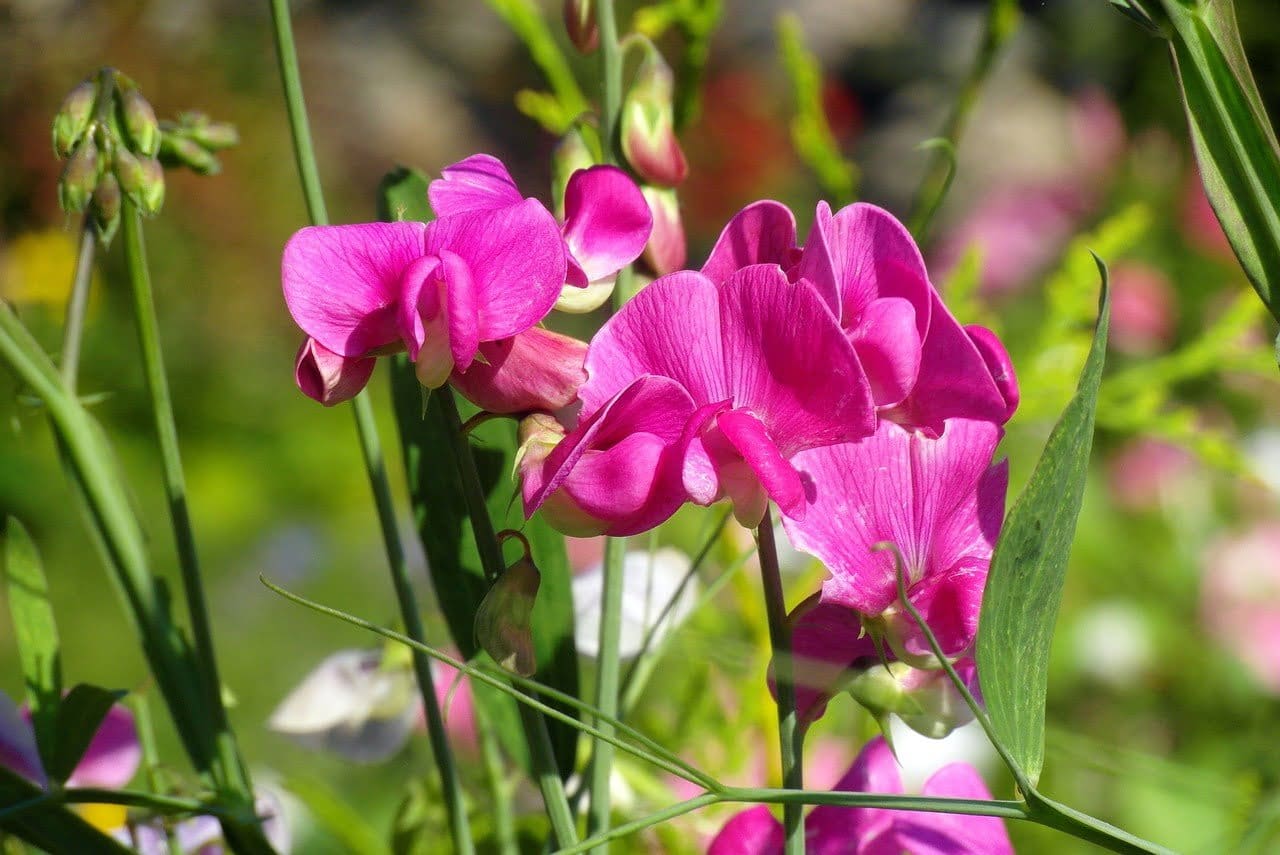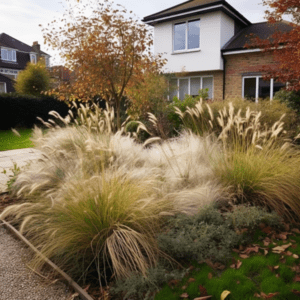Sweet peas are one of the most beloved flowers for gardens. When in bloom, their colorful, fragrant flowers are highly attractive to people and pollinators alike. Though many only think to grow common annual sweet peas, there are also hardy perennial varieties. With the right approach, learning how to grow sweet peas can be quite simple even for beginners.
You might also be interested in: Annuals for Wild Gardens
An Introduction to Growing Sweet Peas
Sweet peas, with their beautiful flowers and enchanting fragrances, are a favourite for gardeners. Though often grown as cool weather annuals, newer perennial varieties expand options for gardens in many climates. With a basic understanding of sweet pea plant needs, achieving success in cultivating these plants is quite attainable.
The small, rounded seeds of sweet peas germinate reliably when planted in prepared soil at the right time. Easy to grow from seed, these climbing vines make excellent displays when given proper structural supports. Well-suited to container gardening, sweet pea plants also mix nicely into ornamental borders or vegetable gardens. For cut flower fans, few other blooms rival fresh picked sweet peas.
When learning how to grow sweet peas, the first step is choosing appropriate varieties. Sweet pea flowers come in a spectrum of colours, including white, pink, red, purple, lavender, blue, and yellow. Both annual and perennial types offer this colour diversity. Matching the varieties to your regional growing conditions is key.
Choosing Sweet Pea Varieties
Many sweet pea varieties thrive in regions with cool summers. But newer types actually tolerate or even require hotter summer weather. Selecting regionally-suited varieties is the first step for success.
Annual Sweet Peas
In most climates, gardeners grow traditional annual sweet peas. Most annual types bloom heavily in spring and set seed before hot midsummer temperatures arrive. Here are some top annual sweet pea varieties:
- Spencer Sweet Peas: The most commonly grown type, these bear large, ruffled flowers on long stems perfect for cutting. Spencer mix seed blends provide a rainbow of colour options.
- Grandiflora Sweet Peas: Flowers are larger than typical annual peas but not as dramatically ruffled as Spencer types. These grow well in hot and humid conditions.
- Dwarf or Bush Sweet Peas: A good option for windy areas, compact dwarf plants reach just 12 to 18 inches tall but produce abundant blooms. These are ideal for container growing.
Perennial Sweet Peas
In recent years, plant breeders have crossed traditional sweet peas with their heat-loving cousins from the Mediterranean. These new perennial sweet peas thrive and bloom continually in hot summer areas. Two top options include:
- Lathyrus latifolius: Sporting large, showy flower clusters, these vigorous 6 to 8 foot vines bloom from early summer into fall.
- Lathyrus odoratus: Old fashioned, fragrant blooms show off on fast-growing 3 to 4 foot vines. These rebloom sporadically into fall after early summer flowers fade.
Once the ideal sweet pea varieties are selected, preparing the planting site is next.
Preparing Planting Sites for Sweet Peas
Sweet peas require well-drained yet nutrient-rich soil for best growth and floral displays. They also need reliable structural supports to climb upon as they grow.
Good Soil Preparation Is Vital
Sweet peas like soil pH right around 6.5 to 7, though lime can be applied to raise pH if soils are more acidic. Adding aged compost or well-rotted manure before planting enriches the soil nicely.
It is wise to test soil drainage before sowing or transplanting sweet peas. Dig down about a foot deep in planting beds after a good rain. If water is still puddled more than a day later, extra amendments to improve drainage are needed.
Whether growing in garden spaces or containers, incorporating organic material like compost into soil provides nutrients. Reliable moisture retention is also important, so adding water conservation amendments helps.
Support Structures Make Healthy Vines
Sweet peas use tendrils to grab onto supports as they grow upwards. Providing trellises, fencing or plant cages gives climbing vines the right structure. Install supports at planting time for best results.
In windy garden sites, short wire cages around each planting hole protect tender seedlings. As vines grow, attaching tall trellises to cages keep mature plants supported. For containers, install trellises when first planting.
Plants grown upright on supports yield longer flower stems for cutting. They also allow better airflow and light exposure for plant health. Guiding sweet peas upward prevents vines from flopping over and tangling.
With supportive soil and structures ready, sowing seeds or transplanting seedlings is next.
Sowing Sweet Pea Seeds
Sweet peas may be planted by sowing seeds directly in garden beds or outdoor containers. Starting seeds indoors for later transplanting is also an excellent option.
Starting Seeds Outdoors
The perfect time for sowing outdoors is early spring once soils thaw and drain well. Or schedule fall planting about 8 to 10 weeks before the average first frost date. Here are simple steps for outdoor seeding:
- Dig compost into planting sites to enrich soil. Rake smooth.
- Create a trench 1 inch deep and as long as desired. Install trellises at this point if cage type.
- Sow seeds into the trench according to packet spacing recommendations. Cover with 1 inch of fine soil or compost.
- Water gently daily until seedlings emerge, usually in 14 to 21 days.
Indoor Seed Starting
For faster germination, getting a head start indoors is wise. This ensures transplant readiness once soil temperatures warm adequate outdoors. Follow these tips:
- Fill small containers with seed starting mix. Gently water.
- Sow 2 to 3 seeds in each container according to package depth. Cover and label.
- Provide 16 to 18 hours per day of light. Keep between 65 to 75 F degrees.
- Expect germination in 7 to 14 days. Transplant outside after hardening off when soil warms.
Whether planted directly outdoors or transplanted, providing routine care is vital for success.
Caring for Sweet Peas
Sweet peas are not high maintenance plants, but they do have some particular preferences. Attending to regular water, nutrient, and pest monitoring lets vines flourish.
Watering Needs
Sweet peas require regular moisture for strong root development and lush vegetative growth. About an inch of water weekly is perfect. Simple ways to evaluate plants’ moisture needs include:
- Push a finger an inch into soil around plants. If dry, it is time to water.
- Check soil consistency. Well drained soil should be moist but not muddy.
- Monitor plants for drooping leaves, a signal plants need water.
Container plantings and new transplants need more frequent watering. Establish irrigation systems or plan to hand water to maintain soil moisture. Adding mulch around plants holds water longer.
Fertilizer Feeding
While compost amended soils contain some nutrients, growing sweet peas need consistent replenishment. Use a balanced vegetable fertilizer, mixed according to label rates.
Ideal timing for fertilizer applications is every 2 to 3 weeks from seedling stage through flowering. Side-dress vines by sprinkling granules around the root zone before watering in.
Discontinuing fertilizer midsummer allows plants to harden off naturally. This promotes better cold tolerance for overwintering plants.
Pinching Sweet Peas
“Pinching” is simply removing the plant’s tender, growing tips. For sweet peas, pinching makes plants “branch out” more, creating thicker foliage and more flowering stems.
Begin pinching about 4 weeks after transplanting seedlings. Use sharp, clean pruners to snip 1⁄4 inch off each vine tip.
Follow up by pinching new shoots every couple weeks through early summer. Take care not to remove swelling flower buds.
Proper pinching, combined with trellising, makes sweet pea vines quite bushy and loaded with flowers. It also controls sprawling, tangled growth effectively.
With supportive soil care, vines readily take off. Keep monitoring for potential pest or disease troubles which may need remedies during this rapid growth phase.
Troubleshooting Sweet Pea Problems
Sweet peas are typically quite hardy plants when basic needs are met. However, they can encounter issues with pests, diseases or environmental stresses. Resolving these right away prevents major setbacks.
Pest Control and Prevention
Common insect pests like spider mites, Japanese beetles and especially aphids can attack vines and flowers. Also watch for caterpillars, earwigs or thrips. Routinely inspect the underside of leaves for any insects. Take action at first signs.
Gently spraying pests away with water is the simplest solution. Insecticidal soaps or neem oil also deter many insects safely. Or apply natural predators like ladybugs or green lacewings.
Additionally, pull away and dispose of any severely pest damaged foliage to prevent spreading. This is vital if fungal diseases emerge.
Disease Prevention
Proper planting hygiene, crop rotation and adequate garden clean up prevents many plant diseases. But sweet peas can still be impacted by powdery mildew, leaf spots or root rots.
First avoid overhead watering, which spreads spores. Remove and destroy any significantly diseased foliage to limit infection. Treat remaining plants with sulfur spray or bicarbonate solutions weekly. Amend soil with compost to encourage beneficial microbes.
Environmental Solutions
If plants become stunted or leaves yellow despite adequate water and nutrition, environmental stress may be the issue. Common sweet pea problems tied to weather include:
- Insufficient Sun: Flowers decrease dramatically without at least 6 hours of direct sunlight daily. Relocate containers or thin surrounding plants.
- Extreme Heat: Many annual sweet peas decline above 80 F degree temperatures. Switch to heat-loving perennial varieties instead.
- Hard Frosts: Protect vines with fabric row covers if cold snaps hit before average first frost dates.
Extending the Sweet Pea Season
With sweet peas grown as annual flowers, their showy displays are often lamentably short lived. But employing a few season stretching techniques keeps the flowers coming.
Successive Planting
Sowing small patches of seeds every 2 to 3 weeks from early spring through midsummer is possible. Opt for both early and late-blooming sweet pea varieties to sequence flowers. Also utilize newer perennial types for late summer/fall blooms.
Deadheading for Rebloom
As flowers fade, clip off spent stems just above the first set of healthy leaves beneath blooms. Deadheading redirects plants’ energy into forming new flower buds.
For annual vines, consistent deadheading keeps some flowers coming up until first fall frosts. With perennial types, sporadic rebloom happens summer through fall.
Cutting Sweet Pea Flowers
Harvesting sweet pea blooms for bouquets is easy! Simply cut flowers once blooms open fully. Vase life averages 5 to 7 days for most varieties.
Condition just-cut stems by plunging underwater immediately after cutting. Use floral preservative and refresh vase water to maximize lasting enjoyment of your homegrown sweetpea flowers.
Grow Sweet Peas and Enjoy Fragrant Rewards!
Learning how to grow sweet peas really does not have to be complicated or time consuming. Select the right regional varieties, enrich garden soil, use sturdy supports, and provide routine care. Anyone can succeed with these charming plants!







